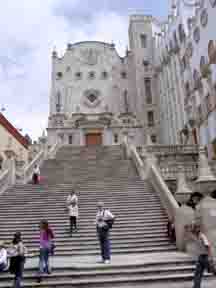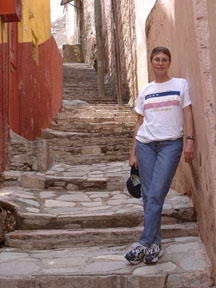|
At
right is Harry on the lower steps of the University of Guanajuato. The
origin of the University goes back to the arrival of the Jesuits and
their founding of the College of the Holy Trinity in 1732. In 1828 it
became the property of the Government of the State and was renamed the
State College. In 1945 it gained university status. This impressive
neoclassical style building, made of green stone, currently houses the
Rector's Office and administrative and academic offices, as well as a
number of the University's schools and faculties.
We visited the Don Quixote museum; we climbed the
hundreds of steps up to the statue of El Pipila. The Pipila monument was
erected in 1939. The rose colored sculpture is in honor of Juan Jose de
los Reyes Martinez. "El Pipila," as he came to be known, was
the hero of the struggle for Mexican Independence. By setting fire to
the portal of the Alhondiga de Granaditas (the grainery) with a torch,
he made it possible to take the building on September 28, 1810.
Following is a picture taken from the hill where the monument is
located, looking down on the city. (Click on the
thumbnail.) Notice the
man standing at the edge of the terrace, lower left, to gain perspective
of the height.
 |
To
the right, I am descending after we climbed the MANY steps from
town up to El Piplia monument. |
|


|




